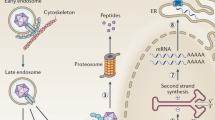Abstract
The neural retina is a logical target of gene therapy for various ocular diseases. We developed a new gene delivery method to the neural retina using an adenoviral vector with a high degree of gene transfection efficiency and less functional damage. An adenoviral vector bearing the lacZ gene (AdCALacZ) was injected into the eyes of adult Wistar rats after an SF6 compression gas vitrectomy and left for 30 min followed by washing with balanced salt solution (BSS) (method A). Three other methods, comprising a simple intravitreal injection (method B), an intravitreal injection after an SF6 compression gas vitrectomy (method C) or a subretinal injection (method D), were also studied. The gene expression was examined 6 days after the AdCALacZ injection. An immunohistochemical study for antivimentin, antiglial fibrillary acidic protein and anti S100 protein antibodies showed the neural retinal cells (Müller cells) to be primarily transfected by methods A, B and C, while only a few cells were transfected by method D. The expression of β-galactosidase was visualized by X-gal staining and the positive areas on each hemiflat mount specimen were measured by an image analyzer and then were adopted as a value of gene transfer efficiency. The highest degree of gene expression was obtained by methods A (23.2% of total retinal area) and C (19.8%), while the lowest degree was obtained by method B (8.9%). The inflammation was observed in all eyes and the value of inflammation was quantified as the average inflammatory cell number in each microscopic field (cells per fields). A moderate degree of inflammation was induced by methods B (28.3 cells per field) and C (27.5 cells per field) and a minimal degree of inflammation was induced by method A (11.2 cells per field). We evaluated the retinal function by measuring an electroretinogram (ERG). The amplitudes of the ERG were depressed in all eyes treated with AdCALacZ. This depression was manifested most by methods B and C, and least by method A. The deterioration in the ERG findings seemed to correlate with the intensity of inflammation. Our study showed that an intravitreal injection with an adenoviral vector can transfer the genes to the neural retinal cells and therefore a vitrectomy and the subsequent removal of the adenoviral vector, can thus significantly improve the transfection efficiency and also reduce the degree of functional damage.
This is a preview of subscription content, access via your institution
Access options
Subscribe to this journal
Receive 12 print issues and online access
$259.00 per year
only $21.58 per issue
Buy this article
- Purchase on Springer Link
- Instant access to full article PDF
Prices may be subject to local taxes which are calculated during checkout
Similar content being viewed by others
Author information
Authors and Affiliations
Rights and permissions
About this article
Cite this article
Sakamoto, T., Ueno, H., Goto, Y. et al. A vitrectomy improves the transfection efficiency of adenoviral vector-mediated gene transfer to Müller cells. Gene Ther 5, 1088–1097 (1998). https://doi.org/10.1038/sj.gt.3300701
Received:
Accepted:
Published:
Issue Date:
DOI: https://doi.org/10.1038/sj.gt.3300701
Keywords
This article is cited by
-
Simian immunodeficiency virus-based lentivirus vector for retinal gene transfer: a preclinical safety study in adult rats
Gene Therapy (2003)
-
Inhibition of retinal neovascularisation by gene transfer of soluble VEGF receptor sFlt-1
Gene Therapy (2002)
-
Gene transfer of soluble TGF-β type II receptor inhibits experimental proliferative vitreoretinopathy
Gene Therapy (2002)



